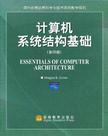计算机系统结构基础
出版时间:2005-12 出版社:北京蓝色畅想图书发行有限公司(原高等教育出版社) 作者:科默 页数:369
Tag标签:无
前言
当我被派去帮忙拯救本科生的计算机系统结构这门课程时,便开始酝酿本书的编写了。计算机系统结构课程遭受了多年的忽视:虽然很多教授和访问学者都讲授过这门课程,但他们往往对数字硬件缺乏兴趣,或缺乏相关的知识背景,从而使这门课程已经退化成各种硬件体系结构相关知识的大杂烩。在÷些学期里,学生们将一门课程的所有时间都花在学习布尔代数上,却毫不涉及实际的硬件;而在另外一些学期里,学生们只学习某一种汇编语言晦涩难懂的细节,却完全不了解其他的语言。那么,计算机系统结构这门课程还值得保留吗?绝对值得保留!在众多计算机科学的教学计划中,计算机系统结构这门课程是学生们了解有关计算机结构的基本概念的唯一机会。对硬件的理解使学生能够编写效率更高、错误更少的程序。广义上讲,体系结构的基本知识有助于理解编程选择的因果关系,从而帮助程序员提高程序效率。此外,了解硬件的工作原理使程序员能够迅速找出程序出错的根源,从而改进编程过程。最后,毕业生们必须理解体系结构的基本概念,才能通过像Intel和Microsoft这样的公司的招聘测试。拯救系统结构这门课程的步骤之一就是寻找一本合适的教材。我们发现,现有的教材大致可以分为两类:一类面向将来会从事硬件设计的工程类低年级学生;另一类则面向计算机科学系的学生,并试图囊括编译器、操作系统和网络协议(至少一种)等诸多内容。这些教材都不适合作为单独的入门级计算机系统结构课程的教材。我们需要这样一本教材:(1)重点介绍概念而非工程细节(因为我们的学生并不会去深究硬件设计);(2)从程序员的角度来阐述系统结构这一主题,并强调其对程序员的重要意义;(3)不应涵盖多门课程的内容。当我们无法找到这样的教材时,唯一的办法就是编写一本。本书主要分为五个部分。第l部分讲述数字逻辑、逻辑门和数据表示的基础知识,重点是数据表示这一章,这是因为二进制补码运算和整数值域的概念是编程的基础。第Ⅱ、第Ⅲ和第Ⅳ部分分别介绍体系结构的三个基本组件:处理器、存储器和I/O系统。各章都为学生提供了充足的背景知识,以便理解系统操作机制及其对于程序员的意义。最后,第V部分讨论了一些高级论题,例如并行处理、流水线技术以及性能。附录主要介绍此课程的一个重要组成部分:实验,学生们可以通过实验进行学习。虽然大多数实验问题都要求通过编程解决,但在开始的几个星期内,学生们应该在实验室里将一些门电路焊接在电路板上。这些器材并不贵(平均每个学生花费不到15美元,用于购买固定设备;每个学生花费不到20美元就可以买到一套属于自己的芯片)。
内容概要
本书主要分为五个部分。第1部分讲述数字逻辑、逻辑门和数据表示的基础知识,重点是数据表示这一章,这是因为二进制补码运算和整数值域的概念是编程的基础。第Ⅱ、第Ⅲ和第Ⅳ部分分别介绍体系结构的三个基本组件:处理器、存储器和I/0系统。各章都为学生提供了充足的背景知识,以便理解系统操作机制及其对于程序员的意义。最后,第V部分讨论了一些高级论题,例如并行处理、流水线技术以及性能。本书为全英文版。
作者简介
Douglas Comer博士在计算机系统领域有着广泛的知识背景,而且一直从事着软件和硬件的教学与研究工作。Comer在软件方面的研究工作横跨计算机系统的各个领域,包括编译器和操作系统。他构建过一个完整的操作系统,包括进程管理器、内存管理器以及串行接口和并行接口的设备驱动程序。Comer也为常规计算机和网络处理器编写过网络协议软件和网络设备驱动程序。他开发的操作系统Xinu和TCP/IP协议栈已经被应用于商业产品中。 Comer的硬件工作经验包括设计离散元件、逻辑门电路以及基本的硅工艺经验。他已经编写了几本畅销的关于网络处理器体系结构的教材。在贝尔实验室,Comer研究过USSI设计并设计了一种VLSI芯片。 Comer是普度大学计算机科学系的著名教授,他致力于计算机系统结构、操作系统、网络和Internet方面的开发、教学和研究。Comer建立了几个创新实验室,使得学生可以建立和测试各种系统,例如操作系统和IP路由器;Comer的所有课程都包括实验。他还不断地在世界各地的大学、工业界和会议上进行咨询和演讲。 除了编写一系列享誉世界的计算机操作系统、网络、TCP/IP和计算机技术等方面的书籍外,Comer还兼任Software:Practice and Experience杂志的主编。他是ACM成员、普度大学教学学会成员,获得过无数嘉奖,其中包括USENIX终身成就奖(USENIXLifetime Achievement Awed)。
书籍目录
PrefaceChapter I Introduction And Overview 1.1 The Importance Of Architecture 1.2 Learning The Essentials 1.3 Organization Of The Text 1.4 What We Will Omit 1.5 Terminology: Architecture And Design 1.6 Summary PART 1 Basics Chapter 2 Fundamentals Of Digital Logic 2.1 Introduction 2.2 Electrical Terminology: Voltage And Current 2.3 The Transistor 2.4 Logic Gates 2.5 Symbols Used For Gates 2.6 Construction Of Gates From Transistors 2.7 Example lnterconnection Of Gates 2.8 Multiple Gates Per Integrated Circuit 2.9 The Need For More Than Combinatorial Circuits 2.10 Circuits That Maintain State 2.11 Transition Diagrams 2.12 Binary Counters 2.13 Clocks And Sequences 2.14 The Important Concept Of Feedback 2.15 Starting A Sequence 2.16 Iteration In Software Vs. Replication In Hardware 2.17 Gate And Chip Minimization 2.18 Using Spare Gates 2.19 Power Distribution And Heat Dissipation 2.20 Timing 2.21 Physical Size And Process Technologies 2.22 Circuit Boards And Layers 2.23 Levels Of Abstraction 2.24 Summary Chapter 3 Data And Program Representation 3.1 Introduction 3.2 Digital Logic And Abstraction 3.3 Bits And Bytes 3.4 Byte Size And Possible Values 3.5 Binary Arithmetic 3.6 Hexadecimal Notation 3.7 Notation For Hexadecimal And Binary Constants 3.8 Character Sets 3.9 Unicode 3.10 Unsigned Integers, Overflow, And Underflow 3.11 Numbering Bits And Bytes 3.12 Signed Integers 3.13 An Example Of Two's Complement Numbers 3.14 Sign Extension 3.15 Floating Point 3.16 Special Values 3.17 Range Of lEEE Floating Point Values 3.18 Data Aggregates 3.19 Program Representation 3.20 Summary PART 2 ProcessorsPART 3 Memories
章节摘录
插图:The important point is that moving up the levels of abstraction allows US to hidemore details and talk about larger and larger pieces without giving internal details.When we describe processors,for example,we can consider how a processor workswithout examining the internal structure at the level of gates or transistors.An important consequence of abstraction arises in the diagrams architects and en.gineers use to describe digital systems.As we have seen,schematic diagrams canrepresent the interconnection of transistors,resistors,and diodes.Diagrams call also beused to represent an interconnection among gates.In later chapters,we will use high-level diagrams that represent the interconnection of processors and memory systems.Insuch diagrams,a small rectangular box will represent a processor or a memory withoutshowing the interconnection of gates.When looking at an architectural diagram,it willbe important to understand the level of abstraction,and to remember that a single itemin a high.1evel diagram Can correspond to an arbitrarily large number of gates.2.24 SummaryDigital logic refers to the pieces of hardware used to construct digital systems suchas computers.As we have seen,Boolean algebra is an important tool in digital circuitdesign;there is a direct relationship between Boolean functions and the gates used toimplement combinatorial digital circuits.We have also seen that Boolean logic valuesCan be described using truth tables.A clock is a straightforward mechanism that emits pulses at regular intervals.Aclock allows a digital circuit to change without requiring inputs to change,and can beused to provide synchronization among muldple parts of a circuit.Although we think of digital logic from a mathematical point of view,buildingpractical circuits involves understanding the underlying hardware details。In particular,besides basic correctness,engineers must contend with problems of power distribution,heat dissipation,and clock skew.
编辑推荐
《计算机系统结构基础(影印版)》由高等教育出版社出版。
图书封面
图书标签Tags
无
评论、评分、阅读与下载
用户评论 (总计0条)
相关图书
- 计量地理学
- 政府门户网站
- 电子政务基础
- 传感器与检测技术
- 金融工程学
- 用科学的理论武装人--全国教育系统学习《邓小平文选》和建设有中国特色社会主义理论
- 幼儿园管理
- 图书馆自动化课程教学大纲
- 物理学习指导与练习
- 市场调查与分析
- 网络技术与应用实训
- 普通语言学概要
- 维克多中学英语阅读教程(高一分册)
- 国防教育新论
- 按例学用电脑三维动画设计--3DS MAX 3.0+COOL 3D 3.0中文版
- 桃优质稳产高效栽培
- 世界政治经济与国际关系
- 维修电工考级指南
- 维修电工技能训练
- 大学英语教学大纲(通用词汇表1~4级)
- 学习建设有中国特色社会主义理论文献选编
- 养鳖百问
- 元素化学(中册)
- 化工原理。下册
- 中西医结合儿科学
